When to Use "Horny" in English: Complete Usage Guide

Written by
Ernest Bio Bogore

Reviewed by
Ibrahim Litinine

Understanding when and how to use the word "horny" requires navigating both its legitimate linguistic applications and its social implications. This analysis cuts through the confusion to deliver actionable insights about proper usage in contemporary English.
The Critical Context Problem
Most discussions about "horny" focus on definitions without addressing the core issue: contextual appropriateness. The word dates to late 14th century, originally meaning "made of horn," before evolving to include its colloquial sexual meaning by 1889. This etymological journey matters because understanding origin informs proper usage.
The fundamental challenge lies not in what "horny" means, but in recognizing when each meaning applies. Professional communication, academic writing, and casual conversation each demand different approaches to this multifaceted term.
Primary Definitions and Applications
Physical/Material Context
The original meaning describes objects composed of or resembling horn. Something that is horny is hard, strong, and made of horn or of a hard substance like horn. This usage appears frequently in biological, agricultural, and descriptive contexts.
Appropriate applications include:
- Scientific descriptions: "The beetle's horny exoskeleton provides protection"
- Agricultural contexts: "Workers develop horny calluses from manual labor"
- Anatomical references: "Birds possess horny beaks adapted for their diet"
This meaning carries no social stigma and functions as standard descriptive language across all professional settings.
Slang/Sexual Context
The colloquial meaning "lustful, sexually aroused" derives from the late 18th century slang expression "to have the horn," suggestive of male sexual excitement. This usage evolved beyond its original gender-specific application to describe sexual arousal generally.
The sexual connotation dominates contemporary understanding, creating potential communication barriers even when the speaker intends the literal meaning.
Strategic Usage Guidelines
Professional and Academic Settings
Professional communication requires careful consideration of context and audience. When referring to physical properties, alternative terms often provide clearer communication:
- Instead of "horny texture," use "callused" or "hardened"
- Replace "horny material" with "horn-like substance"
- Substitute "horny growth" with "keratinized formation"
This approach eliminates ambiguity without sacrificing precision. The goal involves clear communication, not avoiding legitimate vocabulary.
Casual Conversation
Informal settings permit more flexibility, but awareness of audience remains crucial. Regional differences, cultural backgrounds, and generational perspectives influence interpretation. Consider whether your intended meaning will translate clearly to your specific audience.
Creative and Literary Applications
Literature and creative writing benefit from the word's dual nature. Authors leverage this ambiguity for wordplay, double entendre, or to convey layered meanings. Context within the broader work typically clarifies intent.
Regional and Cultural Considerations
Language usage varies significantly across English-speaking regions. American English tends toward more direct acknowledgment of the sexual meaning, while British English may display different comfort levels depending on social context.
Understanding your audience's cultural framework prevents miscommunication. What seems appropriate in one setting may cause discomfort or confusion in another.
Historical Evolution and Modern Implications
The Oxford English Dictionary dates horny's current lecherous meaning to 1889, though evidence suggests earlier usage throughout the 19th century. This timeline reveals how slang gradually infiltrated mainstream vocabulary.
The word's evolution demonstrates broader patterns in language development. Terms with dual meanings often see their more provocative interpretations dominate public consciousness, regardless of etymological precedence.
Grammatical Applications
Adjective Usage
As an adjective, "horny" modifies nouns directly:
- "The rhinoceros has a horny protrusion on its snout"
- "Construction workers develop horny patches on their palms"
Standard adjective rules apply: comparative forms (hornier, horniest) function grammatically but rarely appear in formal writing due to potential misinterpretation.
Predicative vs. Attributive Positions
Position within sentences affects interpretation:
- Attributive: "The horny surface felt rough" (more likely interpreted as texture)
- Predicative: "The surface was horny" (potentially ambiguous without context)
Strategic positioning can minimize confusion while maintaining linguistic accuracy.
Alternative Vocabulary Strategies
Professional writers often benefit from synonyms that eliminate ambiguity:
For physical properties:
- Corneous (medical/scientific contexts)
- Keratinous (biological descriptions)
- Callused (skin conditions)
- Horn-like (general descriptive use)
For hardened textures:
- Indurated
- Sclerified
- Cornified
- Ossified
These alternatives provide precision without potential misunderstanding.
Digital Communication Considerations
Online communication presents unique challenges. Text-based formats lack vocal tone and facial expressions that typically clarify intent. Social media, professional emails, and digital documents require extra attention to potential misinterpretation.
Search engine optimization and content filtering systems may flag "horny" regardless of intended meaning. Writers creating digital content should consider whether alternative phrasing serves their goals more effectively.
Educational and Academic Contexts
Teaching environments require particular sensitivity. Biology teachers discussing animal anatomy or material science instructors describing physical properties must navigate potential student reactions while maintaining educational integrity.
Effective approaches include:
- Providing clear context before using the term
- Acknowledging the dual meaning when appropriate
- Using scientific terminology when available
- Focusing on educational objectives rather than avoiding legitimate vocabulary
Media and Entertainment Applications
Entertainment media frequently exploits the word's dual nature for comedic effect or innuendo. Austin Powers popularized "Do I make you horny, baby?" capturing the playful side of the term. Understanding these cultural references helps navigate contemporary usage.
Writers and content creators must balance audience expectations with their communicative goals. What works for comedy may fail in serious contexts.
Cross-Cultural Communication
International English usage varies significantly. Non-native speakers may lack awareness of cultural sensitivities surrounding certain terms. Clear communication requires considering whether your audience shares your cultural reference points.
Business communications with international partners benefit from conservative language choices that prioritize clarity over colloquial familiarity.
Legal and Formal Documentation
Legal, medical, and official documents typically avoid potentially ambiguous terms. Professional standards in these fields prioritize precision and clarity above colloquial usage.
When accuracy demands specific terminology, proper context and definition become essential. Medical documentation might specify "horny layer of skin (stratum corneum)" to eliminate any interpretive ambiguity.
Psychological and Social Dynamics
Word choice affects social dynamics beyond mere definition. Using potentially loaded terms can shift conversation tone, create discomfort, or trigger unintended associations. Strategic communication considers these psychological factors alongside literal meaning.
The speaker's intent matters less than the audience's interpretation in determining communication success. Effective usage prioritizes audience comprehension over technical correctness.
Contemporary Usage Trends
Modern English shows increasing comfort with previously taboo terminology, but professional contexts maintain traditional standards. Social media has accelerated linguistic evolution, but workplace communications remain conservative.
Recent cultural references like Hot 'n' Juicy's 1998 declaration "I'm horny, horny, horny" represent shifts toward more open discussion of sexuality, but these changes haven't universally affected all communication contexts.
Practical Application Framework
Effective usage decisions require systematic evaluation:
Context Assessment:
- Formal vs. informal setting
- Professional vs. personal communication
- Audience demographics and cultural background
- Medium of communication
Intent Clarification:
- Primary communicative goal
- Acceptable risk of misinterpretation
- Availability of alternative phrasing
- Importance of specific terminology
Outcome Evaluation:
- Likelihood of successful communication
- Potential negative consequences
- Professional or social implications
- Long-term relationship effects
Learn Any Language with Kylian AI
Private language lessons are expensive. Paying between 15 and 50 euros per lesson isn’t realistic for most people—especially when dozens of sessions are needed to see real progress.
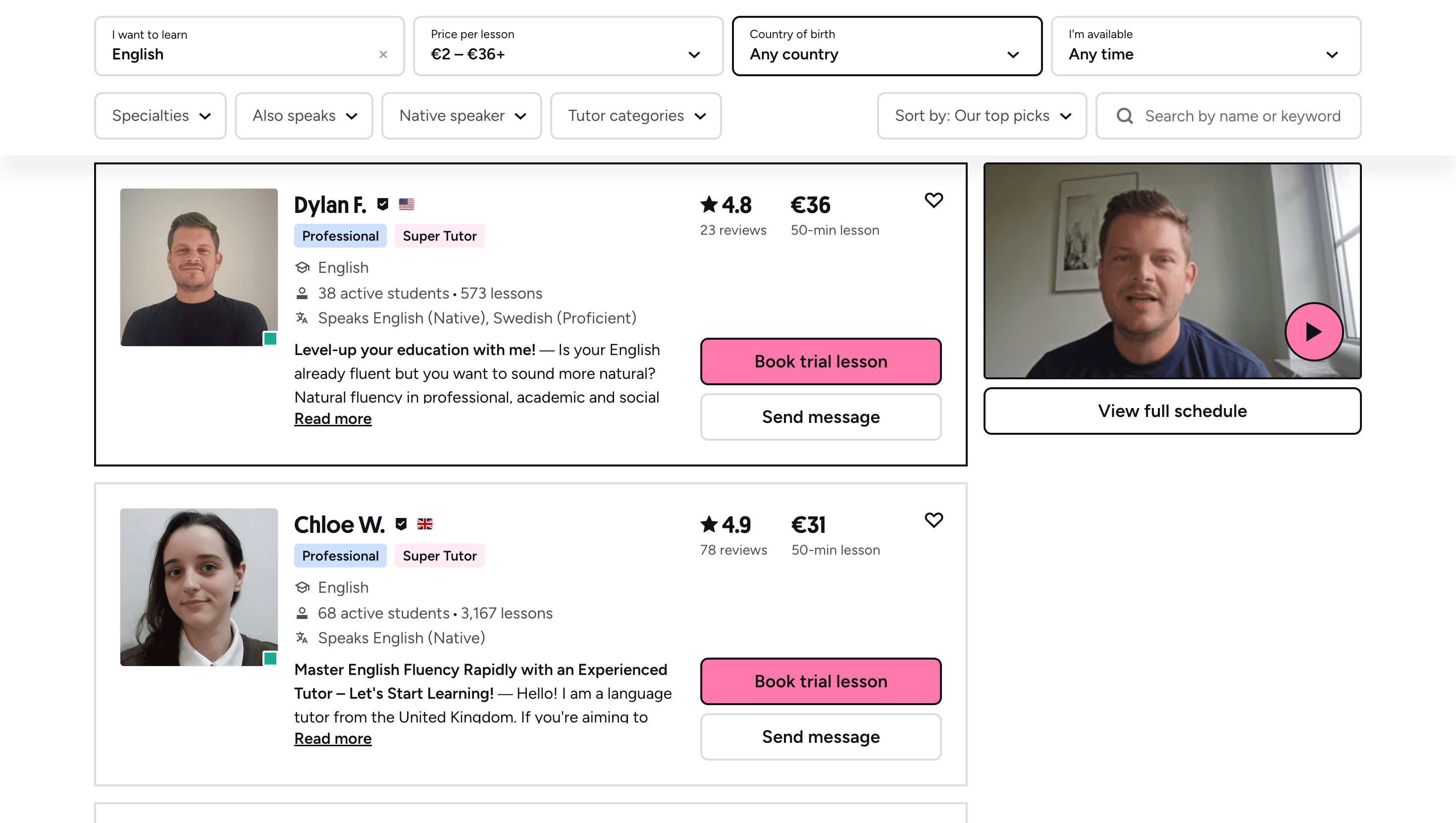
Many learners give up on language learning due to these high costs, missing out on valuable professional and personal opportunities.
That’s why we created Kylian: to make language learning accessible to everyone and help people master a foreign language without breaking the bank.
To get started, just tell Kylian which language you want to learn and what your native language is
Tired of teachers who don’t understand your specific struggles as a French speaker? Kylian’s advantage lies in its ability to teach any language using your native tongue as the foundation.
Unlike generic apps that offer the same content to everyone, Kylian explains concepts in your native language (French) and switches to the target language when necessary—perfectly adapting to your level and needs.
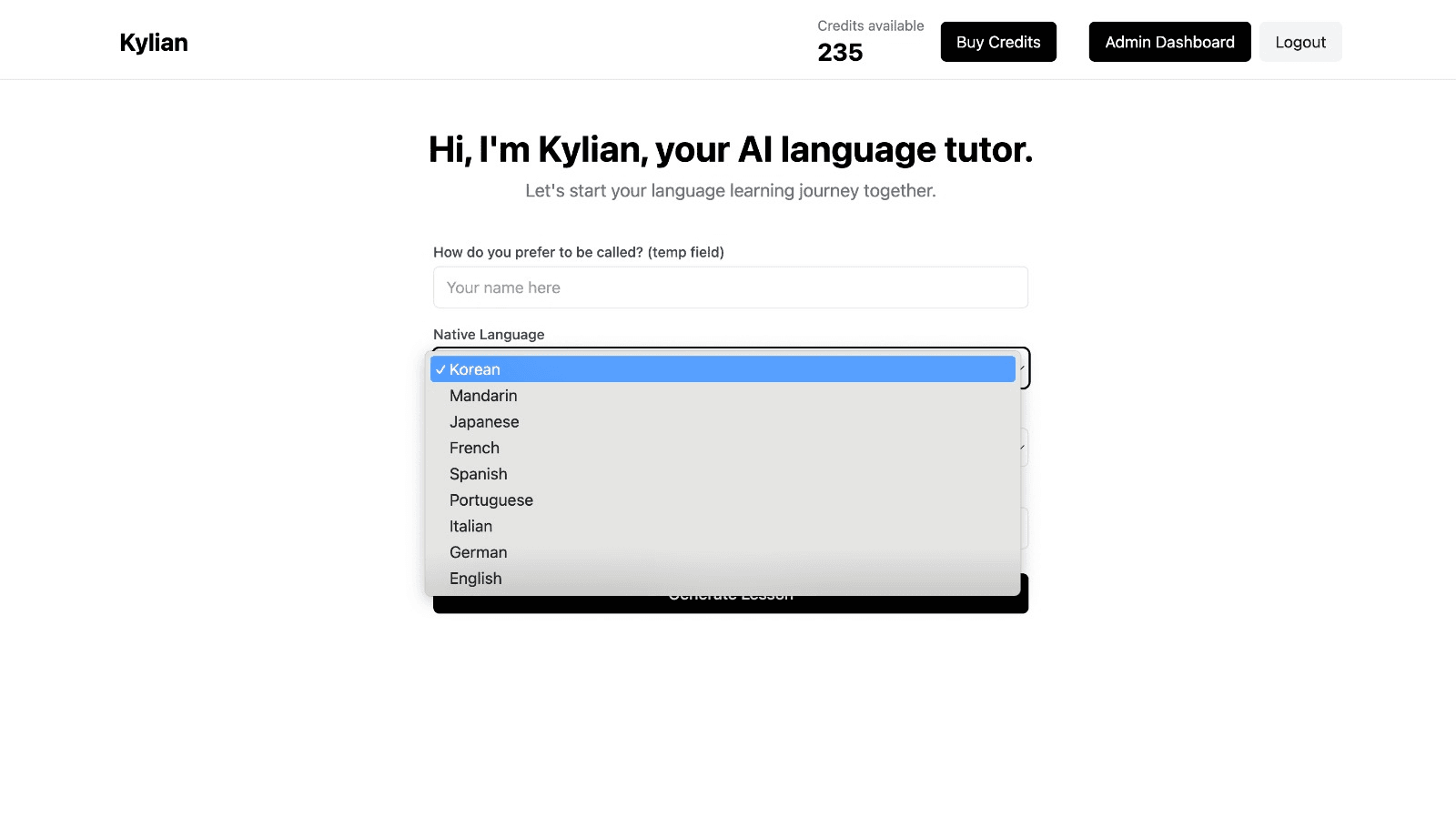
This personalization removes the frustration and confusion that are so common in traditional language learning.
Choose a specific topic you want to learn
Frustrated by language lessons that never cover exactly what you need? Kylian can teach you any aspect of a language—from pronunciation to advanced grammar—by focusing on your specific goals.
Avoid vague requests like “How can I improve my accent?” and be precise: “How do I pronounce the R like a native English speaker?” or “How do I conjugate the verb ‘to be’ in the present tense?”
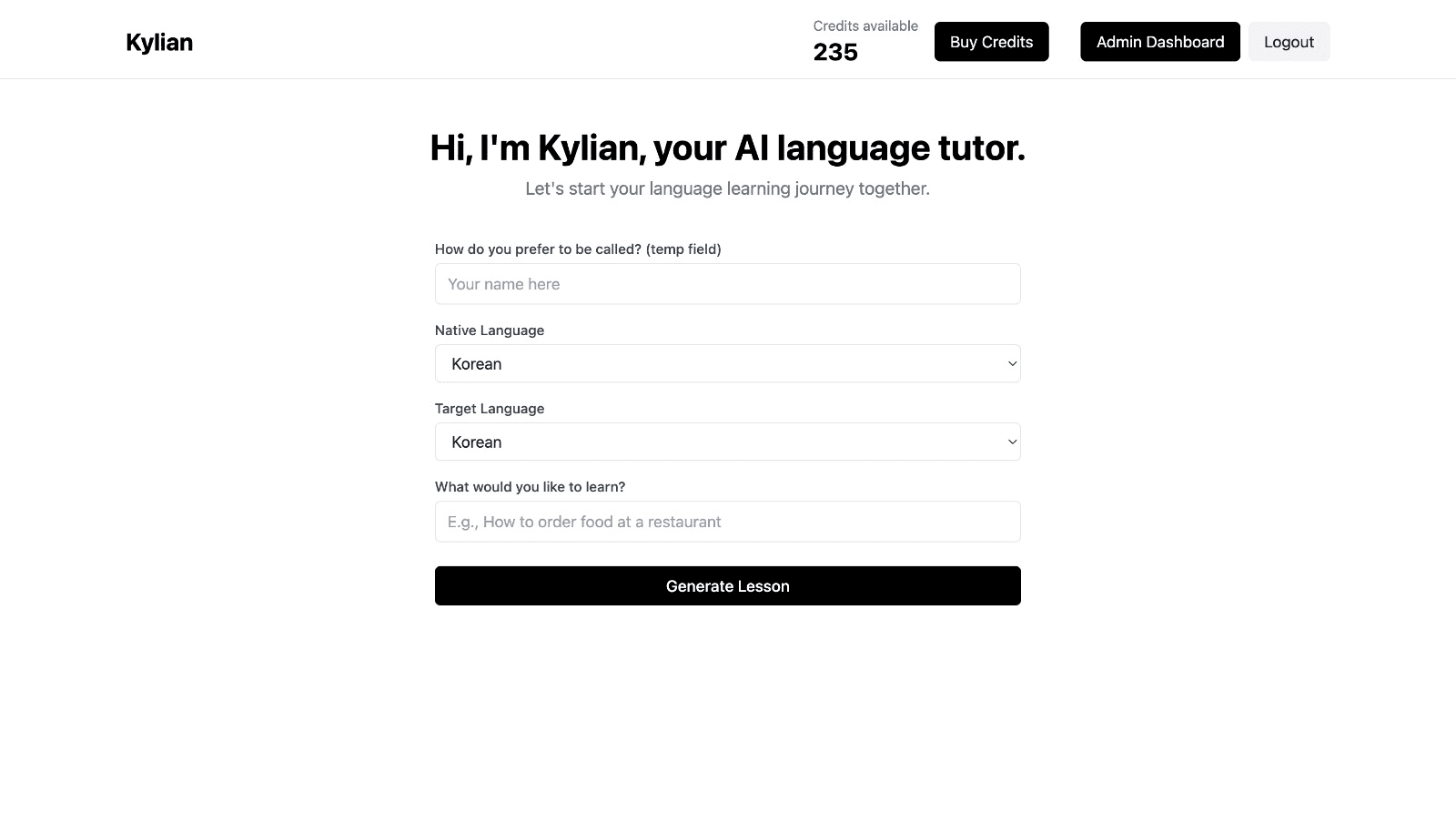
With Kylian, you’ll never again pay for irrelevant content or feel embarrassed asking “too basic” questions to a teacher. Your learning plan is entirely personalized.
Once you’ve chosen your topic, just hit the “Generate a Lesson” button, and within seconds, you’ll get a lesson designed exclusively for you.
Join the room to begin your lesson
The session feels like a one-on-one language class with a human tutor—but without the high price or time constraints.
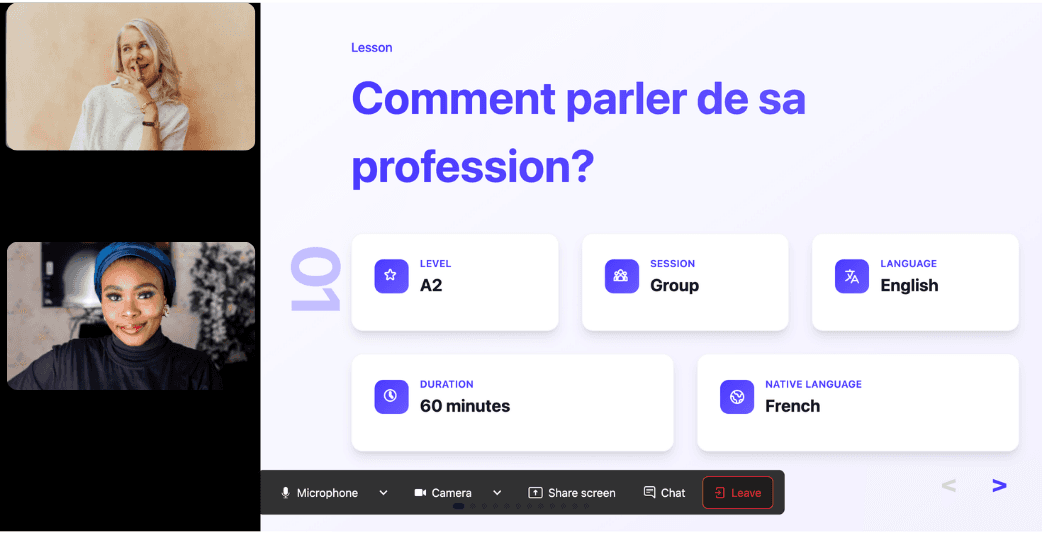
In a 25-minute lesson, Kylian teaches exactly what you need to know about your chosen topic: the nuances that textbooks never explain, key cultural differences between French and your target language, grammar rules, and much more.
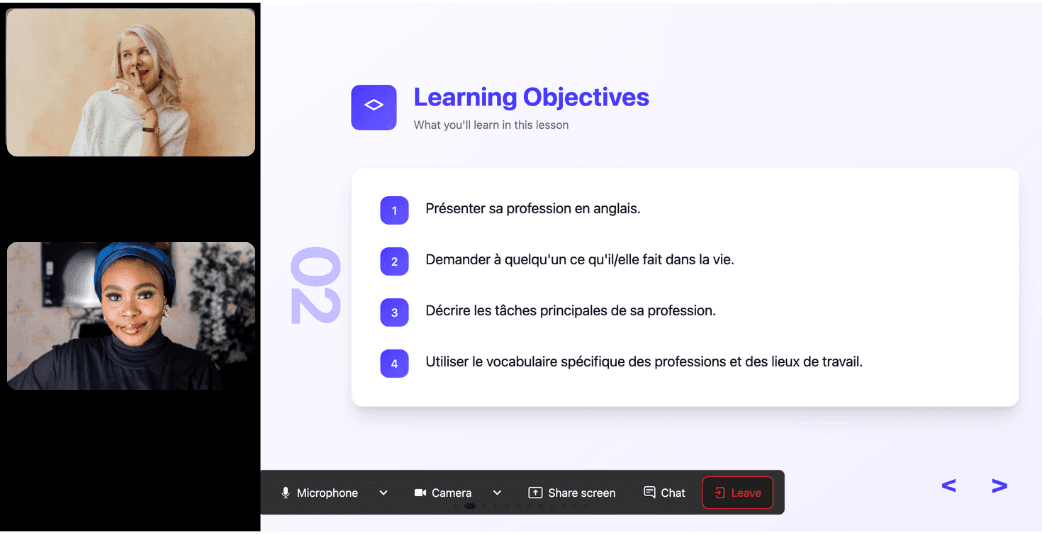
Ever felt frustrated trying to keep up with a native-speaking teacher, or embarrassed to ask for something to be repeated? With Kylian, that problem disappears. It switches intelligently between French and the target language depending on your level, helping you understand every concept at your own pace.
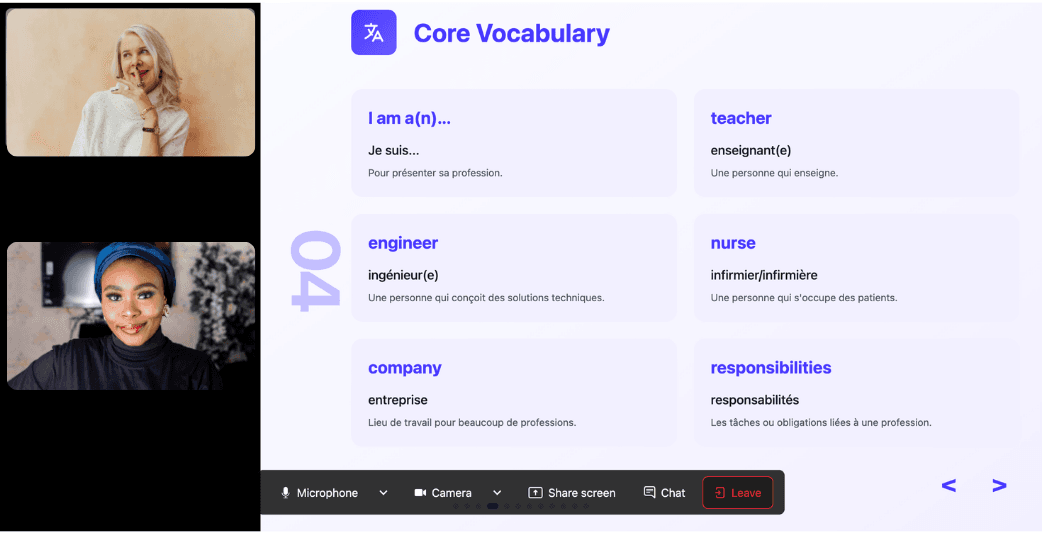
During the lesson, Kylian uses role-plays, real-life examples, and adapts to your learning style. Didn’t understand something? No problem—you can pause Kylian anytime to ask for clarification, without fear of being judged.
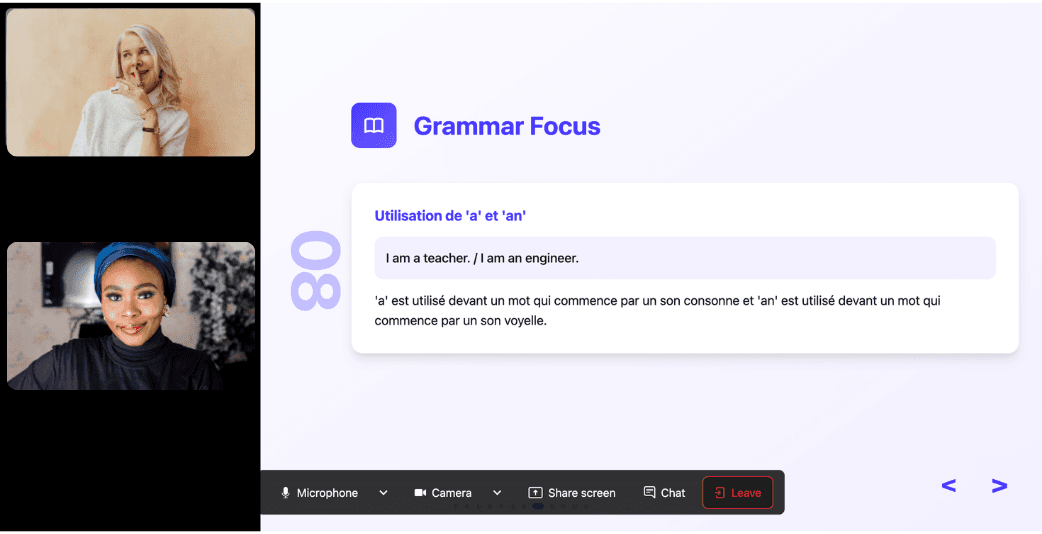
Ask all the questions you want, repeat sections if needed, and customize your learning experience in ways traditional teachers and generic apps simply can’t match.
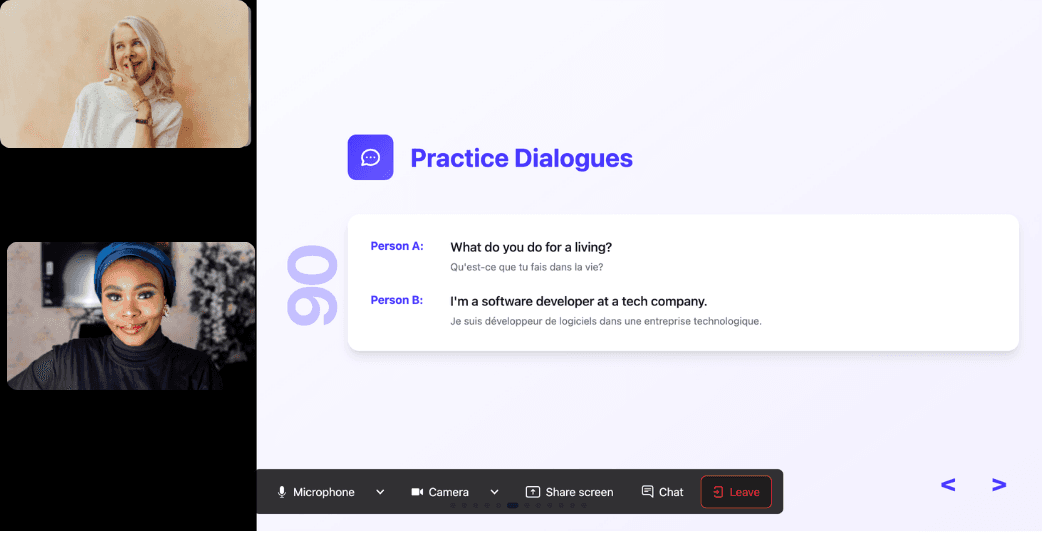
With 24/7 access at a fraction of the cost of private lessons, Kylian removes all the barriers that have kept you from mastering the language you’ve always wanted to learn.
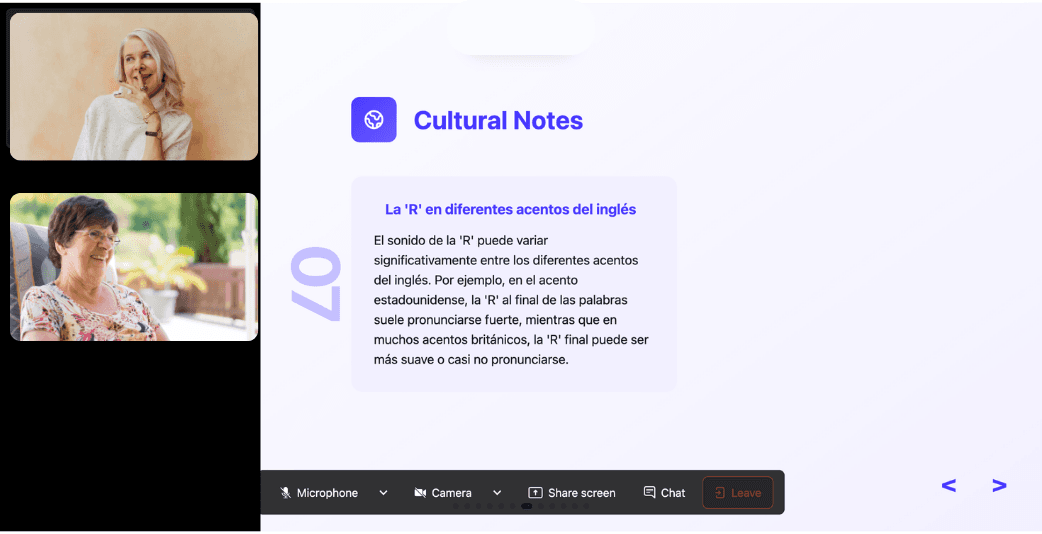
Similar Content You Might Want To Read
![Brazilian vs European Portuguese: Tu vs Você [Portuguese]](/_next/image?url=https%3A%2F%2Fcdn.sanity.io%2Fimages%2F147z5m2d%2Fproduction%2F5b555f3a8e6495ef21d987e182599dce11ee9496-2240x1260.png%3Frect%3D175%2C0%2C1890%2C1260%26w%3D600%26h%3D400&w=3840&q=75)
Brazilian vs European Portuguese: Tu vs Você [Portuguese]
The Portuguese language spans eight countries across four continents, yet most language resources oversimplify its complexity by treating it as a monolithic entity. This reductive approach fails learners who encounter real-world Portuguese speakers and discover that their textbook knowledge doesn't align with actual usage patterns. Portuguese ranks as the world's fifth most spoken language, with over 280 million native speakers distributed across Brazil, Portugal, Angola, Mozambique, Cape Verde, Guinea-Bissau, São Tomé and Príncipe, and East Timor. The linguistic variations across these regions aren't mere regional quirks—they represent fundamental differences that can determine whether you're understood, respected, or even taken seriously in professional contexts. The most critical distinction lies between Brazilian Portuguese (português brasileiro) and European Portuguese (português europeu), particularly in pronoun usage. The choice between "tu" and "você" isn't simply about formality; it reflects deeper cultural attitudes toward hierarchy, intimacy, and social positioning that every serious Portuguese learner must understand.

74 Key Portuguese Phrases Every Beginner Should Know
Learning Portuguese opens doors to vibrant cultures across Brazil, Portugal, Angola, Mozambique, and beyond. Whether planning a trip to Rio de Janeiro, relocating to Lisbon for work, or simply expanding your linguistic horizons, mastering a few key phrases will dramatically enhance your experience. This guide breaks down the most practical Portuguese expressions you'll need for real-world situations. I've curated these based on frequency of use and practical application, ensuring you're equipped with language that matters.

Essential Portuguese Text Slang: Acronyms & Abbreviations
Communication evolves constantly, particularly in the digital sphere where efficiency often trumps formality. Portuguese—whether spoken in Brazil, Portugal, or other Lusophone countries—has developed its own digital shorthand that proves essential for authentic conversations. Mastering Portuguese text slang represents a critical milestone in language proficiency. It bridges the gap between textbook knowledge and practical fluency, offering insights into cultural nuances that formal education rarely addresses. This guide examines the dynamic landscape of Portuguese text expressions, providing you with the tools to decode messages, participate confidently in casual conversations, and understand the cultural context behind these linguistic shortcuts.

How to Learn Portuguese: Practical Tips for Beginners
Portuguese stands as the sixth most spoken language globally, with over 260 million native speakers across four continents. Yet most language learners gravitate toward Spanish, French, or German, overlooking this linguistic powerhouse that opens doors to vibrant economies in Brazil, Portugal, Angola, and Mozambique. The question isn't whether Portuguese deserves your attention—it's how to master it efficiently without falling into the common traps that derail 80% of language learners within their first six months. The traditional approach to learning Portuguese fails most beginners because it treats the language as an academic subject rather than a communication tool. This fundamental misunderstanding explains why countless learners spend months memorizing verb conjugations yet struggle to order coffee in São Paulo. The solution lies in strategic learning that prioritizes practical application over theoretical perfection.

How to Say Hello in Portuguese: Useful Greetings and Phrases
Learning how to say hello in a new language opens doors to meaningful connections and cultural understanding. Portuguese, spoken by over 250 million people globally, offers a rich tapestry of greetings that vary by region, time of day, and social context. Whether you're planning travel to Brazil or Portugal, connecting with Portuguese-speaking colleagues, or simply expanding your linguistic repertoire, mastering these fundamental expressions will enhance your interactions immeasurably. This comprehensive guide will equip you with the knowledge to navigate Portuguese greetings confidently, ensuring your conversations begin on the right note and proceed naturally. Beyond just saying "hello," you'll discover contextually appropriate phrases that demonstrate cultural awareness and respect. Let's embark on this linguistic journey—Vamos começar! (Let's begin!)

Discover the Names of Countries and Nationalities in English
Mastering the vocabulary of nationalities in English opens doors to more authentic communication in global contexts. When we understand how to properly discuss where people come from, we not only avoid awkward conversational gaps but also demonstrate cultural awareness and linguistic competence. In practical terms, nationality vocabulary serves as essential building blocks for international discussions, professional interactions, and travel experiences. Rather than viewing these terms as mere vocabulary items to memorize, consider them tools that enable you to navigate cross-cultural conversations with confidence and precision.